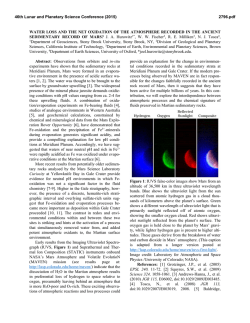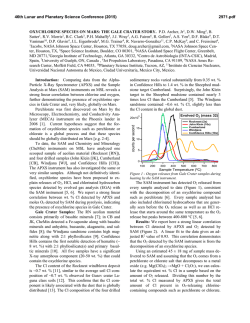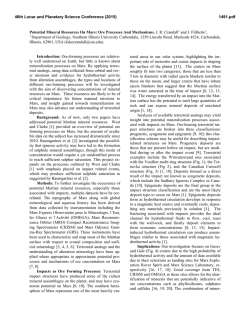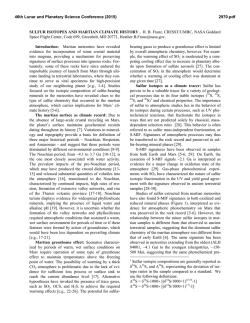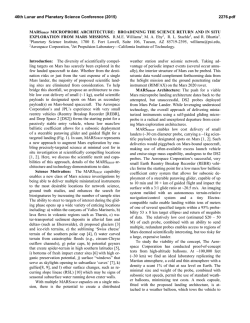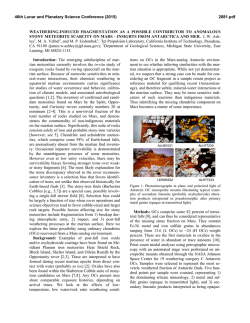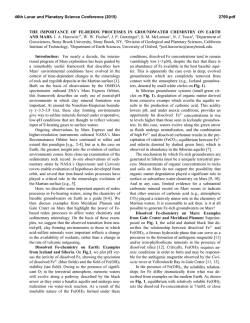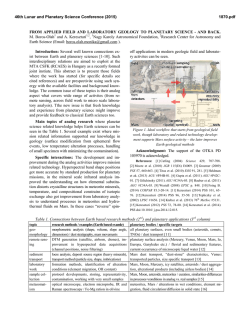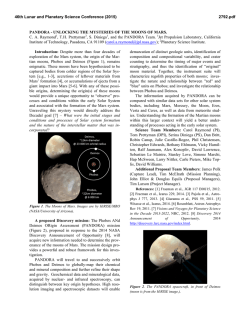
MARTIAN PERCHLORATE CHEMISTRY: PERCHLORATE
46th Lunar and Planetary Science Conference (2015) 2997.pdf MARTIAN PERCHLORATE CHEMISTRY: PERCHLORATE FORMATION AND EFFECT ON ORGANICS. B. L. Carrier*, S. P. Kounaves, and E. A. Oberlin, Department of Chemistry, Tufts University, Medford, MA, 02155, USA ([email protected]) Introduction: Perchlorate (ClO4-) has been directly detected on Mars by the Phoenix Wet Chemistry Laboratory (WCL) at concentrations of ~0.6 wt. % [1]. Perchlorate or other oxychlorine species have subsequently been identified by the SAM instrument on MSL [2], in Mars meteorite EETA 79001 [3], and has been suggested as the possible explanation for the Viking biology experiment results [4]. All of the data points to a global distribution of perchlorate on Mars. The presence of perchlorate has wide ranging implications in terms of the oxidizing nature of the soil, the history of water on mars, the planet’s current water cycle, formation of liquid brines, and for the preservation of organics on the surface. Perchlorate on Mars is most likely formed from mineral or aerosol sources of chlorine due to the lack of gaseous chlorine in the martian atmosphere. Models also indicate that ancient sources of gaseous chlorine were probably insufficient to explain the high levels of perchlorate found in the martian regolith [5], especially considering recent studies which show that perchlorate can be broken down over time by ionizing radiation [6]. Our research points to an ongoing perchlorate formation mechanism in which mineral chlorides can be converted to perchlorate and chlorate under current martian surface conditions in the presence of UV radiation. Perchlorate formation has been demonstrated previously under certain conditions which may be relevant to Mars, especially when brines are present [7-8] but the current research marks the first formation of perchlorate from chloride under Mars conditions with no aqueous phases. The ongoing formation and destruction of perchlorate indicates the presence of multiple oxychlorine species at the martian surface such as ClO-, ClO2- and ClO2(g) as well as other possible radicals such as ●OCl, ● Cl, or ● OH. The presence of these intermediates has implications for the survivability of organics on the surface due to their high reduction potentials. We have run experiments with mellitic acid as well as the amino acid tryptophan in order to determine the effects of perchlorate, as well as its oxychlorine intermediates, on the survival and alteration on these organic molecules. Experimental: Perchlorate formation and organic exposure experiments have been performed in a Mars Simulation Chamber (MSC) which is capable of simu- lating typical Mars surface conditions such as temperature, pressure, atmospheric composition and UV flux. The MSC consists of a stainless steel cylindrical chamber with an internal diameter of 60 cm and a depth of 45 cm. A Mars simulant gas mixture (95.3% CO2, 2.7% N2, 1.6% Ar, 0.13% O2) is introduced into the chamber at a constant rate (8.25 SCCM) through a mass-flow controller. The pressure in the chamber is controlled via a vacuum pump and pressure transducer and can be regulated to typical Mars atmospheric pressure of ~7.5 ±0.1 mbar. Temperature is maintained using a stainless steel cold plate coupled to a recirculating water/refrigerant chiller. Temperature for perchlorate formation experiments was maintained at -15 °C. UV radiation is delivered via a series of filters through a fused silica window located on top of the MSC by a Newport Oriel 1000W Xe-arc lamp in order to simulate the spectrum of UV radiation incident on the martian surface. Figure 1. Mars Simulation Chamber (MSC) Sample preparation: All mineral components are weighed and mixed using an agate mortar and pestle. Chloride or perchlorate salts and/or organics are dissolved in 18.2 megohm-cm water and added to each sample. The sample is then dried, homogenized with a mortar and pestle, and distributed as a thin layer in a pyrex dish. The samples are placed in the MSC, which is then allowed to reach op- 46th Lunar and Planetary Science Conference (2015) timal temperature, pressure and atmospheric composition before the sample is irradiated. After irradiation samples are leached in 18.2 megohm-cm water, typically at a 5:1 ratio, filtered through a 0.2 μm sterile filter and analyzed for perchlorate using a Dionex ICS-2000 ion chromatography system. Organic analyses are performed using a Thermo LTQ HPLC-MS. Sample compositions were as follows: (a) perchlorate formation ClO4- from Cl-: Samples consist of ground silica (SiO2 50-70 mesh), iron(III) oxide (Fe2O3, powder <5 um, ≥ 99.0%), aluminum oxide (Al2O3, powder 10 um, 99.7%), titanium(IV) oxide, anatase (TiO2, powder, 99.8%) and sodium chloride (NaCl, ≥99.0%). (b) ClO4- and organics: Samples consist of ground silica (SiO2 50-70 mesh), calcium perchlorate (Ca(ClO4)2*4H2O 99.8%) magnesium perchlorate (Mg(ClO4)2*6H2O 99.8%), and mellitic acid (Benzene hexacarboxylic acid 99%) or Ltryptophan (≥ 98%). (c) Cl- and organics (to determine effects of intermediates during ClO4- formation): Samples consist of ground silica (SiO2 50-70 mesh), sodium chloride (NaCl, ≥99.0%), and mellitic acid (Benzene hexacarboxylic acid 99%) or L-tryptophan (≥ 98%). Results and Discussion: Our results shows that perchlorate and chlorate are both formed from halite (NaCl) under Mars conditions, and show an increasing yield with increasing UVC dosage (figure 2). Figure 2. Perchlorate formed as a function of UVC dosage. Further experiments also show that the presence of perchlorate has a direct effect on organic molecules and increases their rate of destruction, as well as effecting the degradation products produced during organic destruction. These results show a possible formation mechanism for perchlorate formation on present day Mars, as well as helping to explain the global distribution of perchlo- 2997.pdf rate, and shedding further light on the survivability of organics on the martian surface. References: [1] Hecht M. H. et al. (2009) Science, 325, 64–67. [2] Leshin L. A. et al. (2013) Science, 341, DOI: 10.1126/science.1238937. [3] Kounaves S. P. et al. (2014) Icarus, 229, 206–213. [4] Navarro-Gonzalez R. et al. (2010) J. Geophys. Res., 115, E12010. [5] Smith M. L. et al. (2014) Icarus, 231, 51-64. [6] Quinn R. C. et al. (2013) Astrobiology, 13(6), 515-520. [7] Schuttlefield J.D. et al. (2011) JACS, 133, 17521. [8] Zhao, Y. S. et al. LPSC 2014 Abstract #2534.
© Copyright 2026
